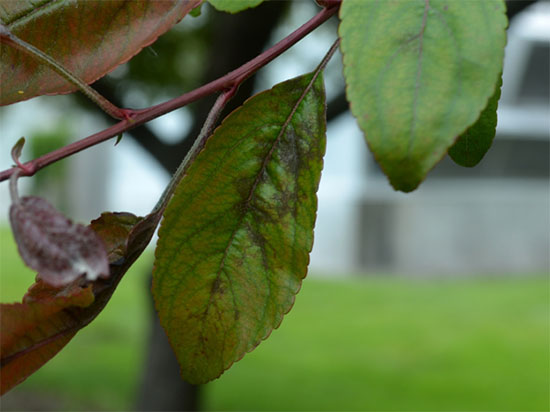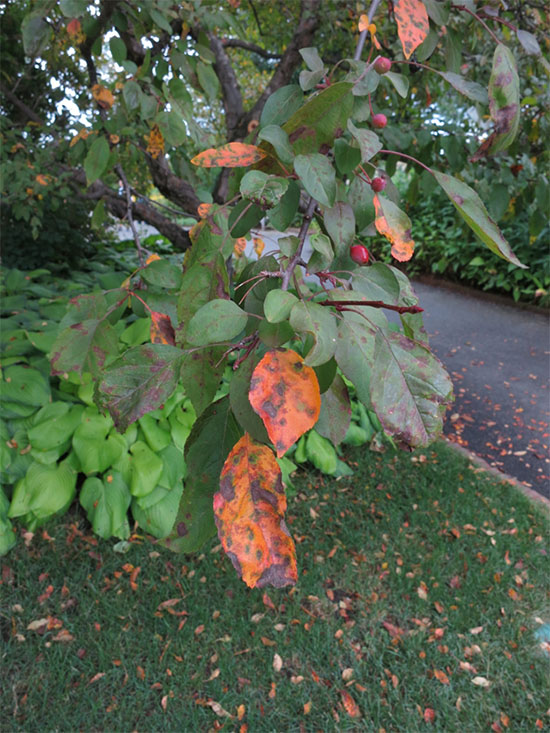Issue 10, June 29, 2015
Crabapple Scab
Apple Scab is an extremely common fungal disease of apple and crabapple caused by the pathogen Venturia inaequalis. In the past few weeks, I have observed symptoms progressing on several susceptible trees. Early symptoms of the disease appear as olive green spots on the foliage. The spots often form along or near the leaf veins, eventually developing a dark, velvety appearance. Infected leaves also may appear curled or puckered. By mid-summer, infected leaves turn yellow, and prematurely drop from the tree. Pre-mature defoliation results in aesthetically unpleasing, thin tree canopies. Defoliation also weakens the tree and may reduce bud development for the following year. Fruits are also commonly affected with symptoms of cracked, black, scabby lesions.

Early symptoms of crabapple scab on Prairifire Crabapple.

Scab infected crabapple leaves changing to a yellow-orange color before falling from the tree.
The pathogen overwinters on fallen diseased leaves and less significantly as fungal spores and mycelia on buds. Mild, rainy spring weather induces spore dispersal from fallen leaves which then cause primary infections. Wet periods, or time in which foliage remains continuously wet, are necessary for infections to take place. The period of time necessary for germination and infection is dependent on temperature. Primary infections can occur is as few as 6 hours with temperatures between 63°F and 75°F. Spores capable of causing secondary infections are produced roughly 1-2 weeks following the initial infection.
Disease control should utilize multiple strategies. Host plant disease resistance is the most effective long-term control strategy. If you are planting new crabapples, look for varieties with resistance to scab as well as rust, fire blight, and powdery mildew which are all common disease of crabapple.
Adequately spacing trees and pruning to improve air flow allow leaves to dry quickly after rains. The goal is to limit the period of time the leaves remain wet. Unfortunately, weather is the biggest factor, and least controllable.
Other control strategies target the fungal spores. Raking and destroying fallen leaves may reduce the amount of fungal spores present. Mulching mowers chop diseased leaves and encourage decomposition. Fall lawn fertilization further helps to decompose disease leaves.
Fungicide sprays are effective at protecting developing leaves on susceptible cultivars. It's too late to protect this year's foliage from infection. The first spray should be applied when leaves just begin to emerge from buds (about 1/4 inch green). Sprays must be continued according to label intervals until 2 weeks after petal fall to give maximum protection. If the tree is free of leaf spots at that point, further treatments are unnecessary.
Intervals between sprays depend on several factors. The product's label provides a range of days between sprays. The shortest labeled interval between sprays is recommended during periods of frequent wet weather and in plantings that had severe scab infections the previous growing season. A longer interval is acceptable during dry weather and in plantings where scab has been less of a problem. (Travis Cleveland)
Author:
Travis Cleveland